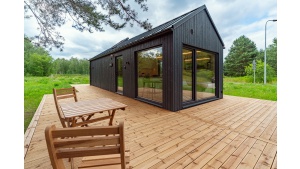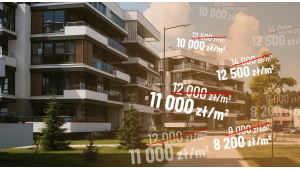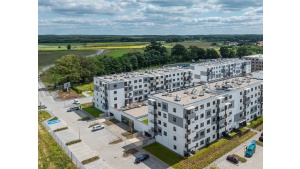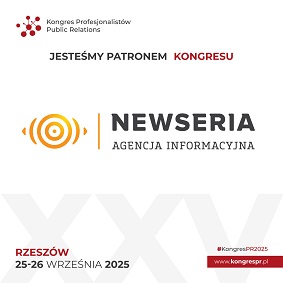Warehouses and retail still bring profits
Prestige PR
Włodarzewska 81C lok 81
02-393 Warszawa
i.wisniewska|prestigepr.pl| |i.wisniewska|prestigepr.pl
508 927 958
www.prestigepr.pl
Bartłomiej Zagrodnik, Managing Partner, CEO of Walter Herz
The investment transaction market in Poland is awaiting revival. It is dominated by smaller acquisitions carried out by regional investors. Larger transactions initiated by international capital are rarely recorded. However, the low activity of Western capital provides a unique opportunity for favorable investment for local players, as demonstrated by the purchasing structure in 2023. The limited competition from global investors and the prevailing buyer's market create an ideal environment for entering investments. The current situation favors opportunistic purchases and the pursuit of even double-digit returns.
The high costs of construction, particularly investment financing, and land prices continue to hinder developers' investment activities. The market awaits interest rate cuts and cheaper capital. The low availability of attractively investable land is driving increasing interest in redevelopment projects, with the most significant scale of this phenomenon observed in the office sector. The office market also faces another challenge, the need to adapt buildings to EU standards related to ESG.
The development of investments is significantly influenced by the global economic slowdown and the current geopolitical situation. However, EU funds can positively impact investments in Poland in 2024 and subsequent years. Despite less favorable conditions, the Polish commercial real estate market is still performing quite well, with some sectors recording very good results.
Warehouses
The underlying factors provide the best prospects and opportunities for further growth in the warehouse and production market. The Polish warehouse sector benefits from the global trend of relocating production closer to markets and shortening supply chains. Demand for warehouse space has exceeded new supply for the past few years. Only last year we saw a greater availability of vacant space, with the vacancy rate now exceeding 7% in our market.
With nearly 32 million square meters of space, Poland ranks third in the European Union in terms of warehouse resources. Last year saw a 12% increase in sector capacity, thanks to the addition of 3.7 million sq m. of space. Despite a slight decrease in construction activity, there are still nearly 3 million sq m. of warehouses under construction in the country, half of which are already contracted. Most investments are concentrated around Wroclaw.
Further growth in the sector is stimulated by high demand, which remained at an impressive level of 5.7 million sq m. in 2023. Demand for space comes from manufacturing companies, logistics operators, retail chains, and e-commerce entities.
Despite a decrease in investment value, warehouse properties were the asset class of choice for investors last year. Properties from this sector generated nearly half of the total value of last year's investment volume.
Retail
In the current conditions, the retail sector is also performing exceptionally well. The retail market in Poland remains in a phase of continuous growth. In 2023, 45 retail investments were completed, increasing national resources by approximately 450 thousand sq m. of space. The influx of new supply into the retail sector marked the largest surge since 2016, surpassing the previous year by several percent. Among the completed projects, retail parks have been dominating for several years, accounting for three-quarters of the new space added last year. In the first quarter of 2024, six more projects in this format entered the market, and the expansion of three retail parks concluded, adding almost 80 thousand sq m. of new space. This year, we will also witness significant activity in the larger shopping center sector, with several modernized facilities scheduled to reopen.
The retail space market continues its expansion with 430 thousand sq m. under construction, primarily driven by new retail parks and local shopping centers, which constitute 80 percent of this growth. Both developers and tenants in this segment have ambitious development plans. Polish Council of Shopping Centers estimates that by 2025, 110 new retail facilities will be established, including 98 parks, potentially increasing retail space in Poland by over 1.2 million sq m.
The dynamics of the retail market are influenced by the return of consumers to in-store shopping, the expansion of network outlets, the debut of new brands, and the launch of new concepts by well-known retail chains. Another significant aspect for the sector is the decline in the e-commerce share of retail trade.
The retail market in Poland is characterized by a very low vacancy rate of 3 percent. We are also observing an increasing number of renovations focused on improving the energy efficiency of buildings and reducing carbon footprints, making properties in this sector more attractive to investors. Interest in purchasing retail assets is coming from new investors from Germany, France, Lithuania, Czechia, and Ukraine.
Offices
The office market, on the other hand, after a period of intense growth, has reached a turning point in its development. The sector's growth has been hindered by a shift in work model, reduced demand for space, high construction and investment financing costs, limited availability of attractive land for office projects, and challenges related to the need to implement ESG standards in buildings. These factors have led to a change in developers' strategies and a drastic decrease in investment activity in this segment. Since 2020, we have witnessed a gradual decline in the amount of office space under construction, whereas just four years ago, Poland was one of the fastest-growing office markets in Europe.
Before the pandemic, the volume of offices under construction in the largest domestic office market remained at around 800 thousand sq m. Nowadays, there is approximately 230 thousand sq m. of space under construction in Warsaw. In 2023, the resources of the Warsaw market increased by only 60 thousand sq m., marking the lowest new supply in several years. Moreover, the process of demolishing and modernizing older office buildings in the capital has begun, resulting in the decommissioning of approximately 30 thousand sq m. of space in the first three months of this year. Around 90 thousand sq m. of space is planned to be delivered in Warsaw this year, with half of it already on the market.
In regional markets, approximately 315 thousand sq m. of new offices were delivered last year, compared to about 400 thousand sq m. completed in 2022. In the first quarter of this year, just over 30 thousand sq m. of offices were added in regions. Estimated data suggests that the increase in office resources in this and the following year in regions will decrease to around 130-150 thousand sq m., more than two-thirds lower than before 2020. It is anticipated that the period of investment slowdown in the office sector may last for several years.
A widely discussed topic recently has been the increase in operational fees in office buildings, driven by inflation, a jump in minimum wages, and service costs. Therefore, environmental issues and increasing energy efficiency in buildings become crucial in terms of demand from tenants and investors. However, adapting office buildings to EU ESG standards means that property owners need to invest significant funds in modernization.
An optimistic signal for the market is the sustained high demand for office space. In 2023, 750 thousand sq m. of space were leased in Warsaw, only slightly less than the record-breaking demand in 2022. However, in the first quarter of this year, 140 thousand sq m. of offices was contracted in Warsaw, about 10 percent less than in the same period last year.
Last year, the absorption of space in the largest regional office markets also remained at a record high level. In the first quarter of 2024, contracts were signed for approximately 140 thousand sq m. of space in regions, with demand decreasing by one-third compared to the previous year.
Tenants are optimizing the space they occupy to reduce expenses. They are scrutinizing lease terms to gain more transparency and control over operational charges. There is also a growing interest in smart technological solutions in buildings that enable more efficient use of workspace and common areas, as well as enhancements to interpersonal experiences.
In the first quarter of this year, the office vacancy rate in Warsaw was 11 percent, with a shortage of available space in the city center. The limitation of new supply in the upcoming years will likely lead to the elimination of surplus space. In regional markets, on average approximately 18 percent of space remains unoccupied.
PRS
The Polish residential market, stimulated by government support programs, is witnessing record-breaking sales figures. High demand coupled with a decrease in supply is causing apartment prices to soar, as well as the prices of land offered for condominium projects in major cities. Investment plots for residential construction are competing with developers from companies operating in the PRS sector.
The institutional rental sector has been gradually but consistently developing in Poland for several years. Its inventory currently exceeds 16 thousand units nationwide, with a record 5.2 thousand apartments introduced to the market last year. This year, investors plan to add another 7.5 thousand apartments for rent. The sector's growth pace is expected to continue at a similar rate. The PRS market in Poland is expected to expand to approximately 40 thousand apartments over the next 4 years.

Łotewski producent wysokiej jakości domów prefabrykowanych wchodzi na polski rynek

Deweloperzy ukrywają ceny mieszkań. Z troski o klientów czy swoje portfele?

Więcej przestrzeni, mniej hałasu – dlaczego Polacy coraz częściej wybierają przedmieścia?
Więcej ważnych informacji
 Jedynka Newserii
Jedynka Newserii

 Jedynka Newserii
Jedynka Newserii

Handel

1 października ruszy w Polsce system kaucyjny. Część sieci handlowych może nie zdążyć z przygotowaniami przed tym terminem
Producenci, sklepy i operatorzy systemu kaucyjnego mają niespełna dwa miesiące na finalizację przygotowań do jego startu. Wówczas na rynku pojawią się napoje w specjalnie oznakowanych opakowaniach, a jednostki handlu powinny być gotowe na ich odbieranie. Część z nich jest już do tego przygotowana, część ostrzega przed ewentualnymi opóźnieniami. Jednym z ważniejszych aspektów przygotowań na te dwa miesiące jest uregulowanie współpracy między operatorami, których będzie siedmiu, co oznacza de facto siedem różnych systemów kaucyjnych.
Ochrona środowiska
KE proponuje nowy cel klimatyczny. Według europosłów wydaje się niemożliwy do realizacji

Komisja Europejska zaproponowała zmianę unijnego prawa o klimacie, wskazując nowy cel klimatyczny na 2040 roku, czyli redukcję emisji gazów cieplarnianych o 90 proc. w porównaniu do 1990 rok. Jesienią odniosą się do tego kraje członkowskie i Parlament Europejski, ale już dziś słychać wiele negatywnych głosów. Zdaniem polskich europarlamentarzystów już dotychczas ustanowione cele nie zostaną osiągnięte, a europejska gospodarka i jej konkurencyjność ucierpi na dążeniu do ich realizacji względem m.in. Stanów Zjednoczonych czy Chin.
Handel
Amerykańskie indeksy mają za sobą kolejny wzrostowy miesiąc. Druga połowa roku na rynkach akcji może być nerwowa

Lipiec zazwyczaj jest pozytywnym miesiącem na rynkach akcji i tegoroczny nie był wyjątkiem. Amerykańskie indeksy zakończyły go na plusie, podobnie jak większość europejskich. Rynki Starego Kontynentu nie przyciągają jednak już kapitału z taką intensywnością jak w pierwszej części roku. Z drugiej strony wyceny za oceanem po kolejnych rekordach są już bardzo wysokie, a wpływ nowego porządku celnego narzuconego przez Donalda Trumpa – na razie trudny do przewidzenia. W najbliższym czasie na rynkach można się spodziewać jeszcze większej zmienności i nerwowości, ale dopóki spółki pokazują dobre wyniki, przesłanek do zmiany trendu na spadkowy nie ma.
Partner serwisu
Szkolenia

Akademia Newserii
Akademia Newserii to projekt, w ramach którego najlepsi polscy dziennikarze biznesowi, giełdowi oraz lifestylowi, a także szkoleniowcy z wieloletnim doświadczeniem dzielą się swoją wiedzą nt. pracy z mediami.



![Nestlé w Polsce podsumowuje wpływ na krajową gospodarkę. Firma wygenerowała 0,6 proc. polskiego PKB [DEPESZA]](https://www.newseria.pl/files/1097841585/fabryka-nesquik_1,w_85,r_png,_small.png)




.gif)

 |
| |
| |
|